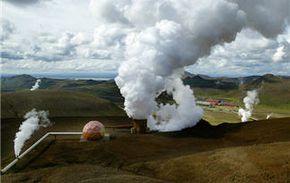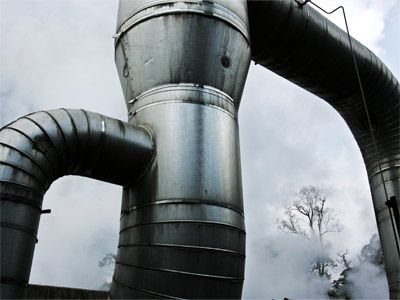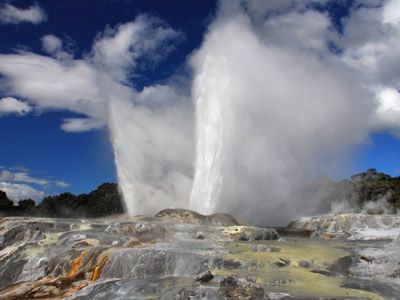The future of geothermal energy can pretty much be summed up with a single word: More.
Geothermal power is often considered the third or fourth most important source of renewable energy, behind solar, wind, and hydro. Right now, it accounts for just a small portion of the world's power capacity -- in 2010, it accounted for just around 10,709.7 MW of installed capacity -- but analysts expect geothermal plants to begin proliferating around the globe at a rapid clip.
Advertisement
The technology is relatively simple; the basics have been understood for years. In fact, the first commercial geothermal power plant was built in Larderello, Italy a full 100 years ago, in 1911. As you'll recall from elementary school science class, heat is continually being generated by a layer of magma below the Earth's crust. That heat rises up to the surface; it's hottest above active volcanic regions and the seismically active spots between tectonic plates.
Though there are different kinds of geothermal power plants, they all do the same basic thing: they capture rising steam or hot water and use it to power an electric generator.
The reason that geothermal is expected to play an important role in the future is that we're getting better and better at doing this: we're now drilling geothermal wells with increasing efficiency, allowing more energy to be captured in each plant.
Engineers have also devised and improved 'binary cycle' plants that release no emissions except water vapor. You see, traditional 'dry steam' geothermal plants emit greenhouse gases -- sure, the emit only 1/8th that of coal plants, but they're emissions nonetheless. Dry steam plants tap directly into the steam coming out of a hydrothermal convection zone, and some inevitably escapes. Binary cycle plants create a closed loop system that runs hot water through a heat exchanger that heats up another liquid, like isobutane, that boils at a lower temperature than water. The hot water is then sent back underground, while the isobutane runs the generator.
Geothermal is also getting cheaper, as the technology improves. According to the Union of Concerned Scientists, since 1980, the cost of operating geothermal power plants has declined by as much as 50%. In some markets, buying power from geothermal plants will soon be as cheap as it is from its much dirtier fossil fuel counterparts.
But the biggest looming technology is called Enhanced Geothermal Systems. See, as of now, only around 10% of the world's area is fit for geothermal power production. That's because you need hydrothermal convection systems -- places where hot water or steam bubbles up to the surface then sinks back down. If we're going to truly take advantage of the potential of geothermal, we'll need to begin injecting water deeper down, in 'hot dry rock' areas.
Why would we want to bother with something like that? Well, as the USUCS notes, The amount of heat within 10,000 meters (about 33,000 feet) of Earth's surface contains 50,000 times more energy than all the oil and natural gas resources in the world."
That's why.
There are a host of researchers diligently pursuing this technology -- the US Department of Energy, Google, and, of course, vested interests in the geothermal industry. There are pitfalls, to be sure -- there's concern that such drilling will cause seismic activity, just as fracking has been shown to do (though no harmful chemicals need be blasted into our aquifers, thankfully). But the extent to which its been shown to stir up trouble has been deemed rather minimal indeed by scientists, and developing EGS could open up truly vast new stores of clean, renewable energy.
Finally, there's been a lot of exciting talk about repurposing old, depleted gas and oil wells as geothermal plants -- those wells could serve as relatively easy infrastructure to repurpose as clean geothermal operations, as opposed to drilling brand new ones.
Clearly, geothermal holds some pretty serious potential. In trying to predict what a clean energy future looks like, some, like the cleantech wiz Saul Griffith, figure geothermal will eventually account for around 1/6th of the world's power supply. Others, like the IPCC, think it will clock in at 4%. Either way, it will be an integral part of the renewable energy mix powering the world, as fossil fuels recede from view.
Advertisement



